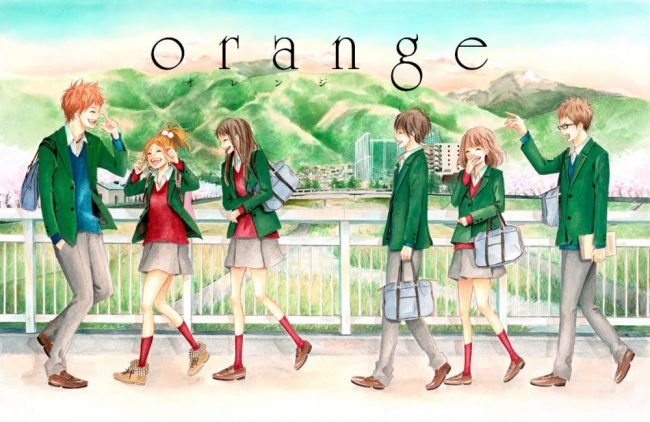The whole second chance notion has really been the focus of 2016 with shows like ERASED, Re:Zero and ReLIFE airing; however, if that wasn’t enough to sate your appetite, we are given another anime about second chances involving time travel. Unlike the previous three, this one is more of a slice-of-life romance story mixed with science fiction. Today, I’ll be taking a look at Orange.
Let’s Jam!
The Story
The story of Orange truly starts ten years in the future where a girl named Naho and her close friends from high school experience sadness and regret over the fact that they were unable to prevent the death of their friend Kakeru. Filled with this sadness and regret, they write letters to themselves ten years in the past with instructions on how to save Kakeru’s life. By some miracle, the letters actually make it to their high school selves. Now guided by these letters, Naho and her friends set out to change the future in order to save Kakeru.
I have to say that Orange’s story, at first, was a bit intriguing. There was a lot of mystery surrounding how the letters got into the hands of their younger selves and the show does do a good job keeping that mystery for the majority of the season. Despite this, when the time came to reveal how it could have been possible for the letters to time travel, it seemed really far-fetched to the point where it really broke my suspension of disbelief. If we subtracted the whole time traveling letters plot from the show and focused on this story a tragic romance, it would have been a hundred times better. The way they tried to incorporate science fiction into the show just make things really awkward.
Granted, the letters giving them the events of each day did help them come up with ways to help alter the future and make life better for Kakeru, but it would have been deeper and more impactful if they had to figure everything out on their own. I also think that it would have been a much bigger shock to the audience had it been that way because they revealed that Kakeru was going to die by the end of the first episode, taking major shock value out of the equation almost immediately. Despite this big flaw, they did do a good job in trying to keep things interesting, especially with a pseudo explanation on time travel laws.
The way they accomplish this is rather subtle, too. Naho and her friends were in a science class and the topic of black holes and time travel came up as part of a physics discussion. There, their professor talked about how changing past and present wouldn’t really do much and that the possibility of alternate world lines exist and that things can differ from line to line. This is the same time traveling principle that was established in Steins;Gate, but on a much deeper scale. Here in Orange, the characters begin to realize that it doesn’t matter what their futures are like because they are in another world line.
The biggest point to drive this home is that in the world line where the letters were sent from, Naho and Suwa were married and had a child. Suwa accepts the fact that in another world line, he was living his dream so this world line should be dedicated to Naho getting together with Kakeru. If Rem from Re:Zero was best girl this year, then Suwa from Orange is best guy for being able to put all of his feelings aside for a friend like that.
All I can say is that it was a good attempt at science fiction, but this really seemed more like a romantic drama. The message here is being able to recognize the patterns within friends who may become suicidal and to be there for them to help prevent something tragic from happening. That should be the message to take away from this show, but the sci-fi aspect of that really muddles and, to a point, cheapens that message.
The Characters
Despite some development between Orange’s characters, a few of them come off as kind of flat. Naho, Kakeru and Suwa got the biggest spotlights while Hagita, Azusa and Takako all seemed to float in the background most of the time.
Naho Takamiya
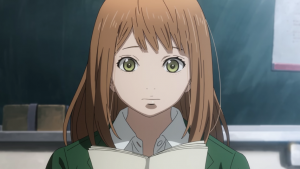
Naho is a typical timid high school girl. She has a plain personality that is always embarrassed whenever she talks to Kakeru. It’s your typical teenage girl crush syndrome that we’ve seen a thousand times. What makes this one fail so hard is that one episode she seems to know she loves Kakeru, her friends know it as well and then the next episode, she seemed completely clueless about her own feelings. This seesawing back and forth on being certain and being unsure really made this relationship hard to watch. I know the Japanese love to taunt their audiences with possible relationships, but this was WAY overdone. Most of the time you want to root for the characters to get together and you end up cheering them on because of it. There are times where you know it’s obvious and you wish they would just get together already and then there is Naho and Kakeru where it’s been so over-teased that you just don’t even care anymore. I didn’t like Naho that much as a main character as I think they just really held back on her way too much.
Kakeru Naruse
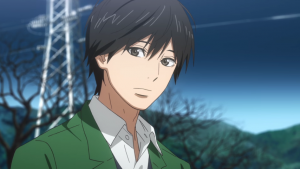
So Kakeru is an emotional wreck. His mother passed away and he feels that he was the one who killed her (metaphorically speaking.) This drives Kakeru to, one day, commit suicide and that is the event that causes his friends, ten years in the future, to write the letters in hopes of saving him. One thing that really bothered me about this show, aside from Naho calling out his name about 50,000 times per episode, was the fact that everyone got a letter… yet they didn’t reveal that to each other until about the half way point of the show. Everyone also knew that Kakeru was going to kill himself and yet, nobody thought of just confronting him straight up about it to save his life then and there. If you’re thinking that they didn’t because he probably wouldn’t have believed them about the letters, then.. SPOILER ALERT… they told him about the letters anyway after Kakeru fails his suicide attempt and he still ends up believing them.
Kakeru didn’t really strike me as a good character either. He didn’t really seem like someone you could get attached to and the fact that he told Suwa and Naho why he was depressed and then lied to everyone else later made zero sense. You had two people who know about your mindset and yet, they did nothing. That should have been the intervention point, but Naho and Suwa chose not to formulate a plan to just intervene right then and there. Instead, they pretend they haven’t said anything, which doesn’t matter because everyone knows due to the letters, but yet… they all wait until the day of the suicide to finally band together to try and stop him? Seriously, what kind of friends do that!?
Hiroto Suwa
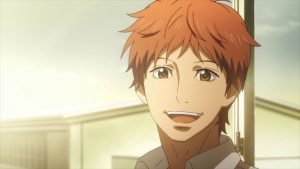
Also known as Good Guy Suwa, he’s Naho’s friend and he loves her unconditionally, but since Naho likes Kakeru and he knows about the future, he decides to throw his own happiness away in order to see Naho end up with Kakeru citing that since his future self already married Naho, he had already lived his dream. That was probably the most selfless, respectful act anyone could have done. It caused Suwa great pain to do that and that makes you respect him as a character, even if he demoted himself to the eternal friend zone. Outside of this, Suwa is the athletic one of the bunch and even invites Kakeru to join his club as a way to try and sway him from killing himself in the future. Suwa is the very definition of a good friend and a white knight. He was the best character out of the six, hands down, as you got to experience the most emotional attachment out of all of them.
Saku Hagita
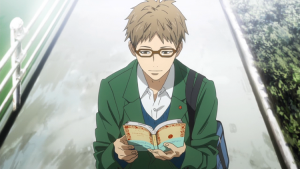
He is the bookworm of the group who is straight-forward and uses logic in his reasoning. Despite this, he’s also kind of a dunce and ends up being comic relief, which is surprising because you wouldn’t expect that out of a character like Hagita. His development comes in the form of a love relationship with Azusa, but it’s one of those relationships where Azusa teases him with it and he denies it over and over despite the fact that it’s blatantly obvious that the two like each other. Saku isn’t very athletic and you get to see that during their school’s festival, but he does end up getting a shining moment during the relay race that makes you want to get behind him. Outside of this, the character is a bit flat and is mostly tailored to being the background.
Azusa Murasaka

What would a circle of friends be without the loud-mouthed obnoxious one? Well, she’s not as bad as that opening question makes her out to be as she can be a bit loud and out there, but it’s dialed back and it makes her tolerable. She’s constantly teasing Saku about being in love with her and she’s also very supportive of Naho and her quest to go out with Kakeru. She also, oddly, plays the role of the voice of reason at times as she has to offer advice to Suwa about what to do with Naho. She wears many hats as a character, which should make her diverse, but I think so much attention was put on Naho and Kakeru that her presence didn’t really make as big of an impact as it should have, if that makes any sense. She plays the role of supporting character perfectly, but it’s because she’s stuck in the main character’s shadows so much that the impact of her actions don’t really carry a lot of weight by comparison.
Takako Chino
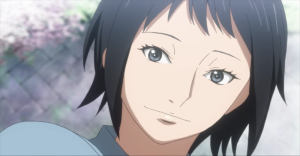
If these six friends were planets in our solar system, then Takako is Planet X. Everyone knows she’s there, but no one really cares. She usually hangs out with Azusa, but aside from being the person to occasionally agree with what others are saying, just what in the hell is her role here? I mean, when Ueda; Kakeru’s first girlfriend, picked on Naho, she did some and flex her mannish muscles and got her to back down, but outside of that one incident, Takako didn’t really have much of an impact on anything. Honestly, the should wouldn’t have changed a bit if she wasn’t even in it and that’s kind of sad.
Art, Animation & Sound
I couldn’t get behind the character designs of Orange all that much. I know this isn’t a shounen show so the art style would look a bit more “human-like,” but Naho and Azusa’s designs just looked so weird. They both had MASSIVE eyes that made them look like dolls more than humans. This also gave rise to a few complications with trying to convey the right kind of expressions when the emotional scenes demanded it. Takako, Suwa, Hagita and Kakeru all had great balance in their designs and they seemed more lifelike than Naho and Azusa. It was actually distracting at some points and it really took me out of the story just by the way they looked in some of the scenes.
The use of color in the show also had this odd combination to it. Some scenes were vibrant, but others seemed a bit faded and flat. I believe a lot of it had to deal with their school uniforms as green against tan/brown just didn’t look all that appealing and it seemed to drown out some of the vividness of the world around them.
Orange’s animation was pretty okay, but nothing to really write home about. There were a lot of still shots that didn’t call for a lot of movement, but that changed during the school festival in the back half of the series. When the animation required it, it stepped up, but it felt like it did only when it needed to. Granted, shows like this don’t tend to be animation heavy, but it just felt pretty average. Don’t mince my words, though. The animation wasn’t terrible and it’s not something that is going to ruin the show by any means, I just felt that they could have done a bit more with it as nothing really jumped off the screen and wowed me.
The OST was also just average and served as good background music. This isn’t the kind of show that warrants an amazing OST, though as there wasn’t any huge fight scenes that could determine the fate of the world or anything. Slice of life shows typically don’t have soundtracks that will leap out at you and Orange is no different. The opening and ending songs also leave a lot to be desired, but it could also be my personal taste in music as well.
Overall Thoughts
Orange had an interesting premise, but the execution fell completely flat. I’m also probably being harsh on this because time travel is my favorite genre of science fiction and I appreciate a work more if it is pulled off correctly. The reasoning behind the letters making to the past seemed really far-fetched and cheesy that it ruined all of the build-up and mystique throughout the series. The characters didn’t give you any reason to get attached to them with the exception of Suwa. Naho and Kakeru’s emotions felt so forced that I just couldn’t really care by the end of the series.
In fact, when Kakeru attempted suicide, I said “well, they did say in the show you can’t change the past” so I expected him to die. When I saw that he failed and lived, I said “Oh, well they changed the past. Mazel tov. You did it. Roll the credits now, please?” I felt the whole “world line” explanation also gave them the excuse of not showing how the future changes for them now that Kakeru was saved. It means that Kakeru is dead and gone forever in the world line where they sent the letters, but now in the word line where he’s alive, a new future is born. Yet, this breaks their own law of time travel because if what happens in one world line doesn’t affect the other, then how did the letters get moved from one world line to the other? By their own logic, the letters should have gone back in time to their own world line.
Unless they are trying to say that the letters did do that and a new world line was born, but even still, that means something changed in their own world line and they should have felt SOMETHING change, but they didn’t.
Whatever.
Good attempt Orange, but I just couldn’t buy into what you were selling.

If you enjoyed this review, please consider following me on Twitter @TheAnimePulse
Until next time,
Ja ne!
Orange
Summary
Orange could have been a tremendous romance drama, but the sci-fi elements, while a good attempt, soured on what could have been an amazing story.


